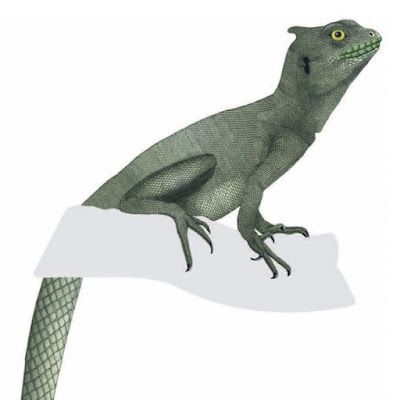


Yo I'm Ivel, a Spanish derg who likes lizards, videogames and worldbuilding. My interests are quite varied and are often a mess but I particularly enjoy videogames and storytelling! I occasionally draw as well.
My Carrd: ivelleviathan.carrd.co
A stealthy species from the Patagonian Desert! They hunt insects and other invertebrates. They spend most of their time hiding between rocks and have the perfect coloration to camouflage in the rocky desert areas!

A stealthy species from the Patagonian Desert! They hunt insects and other invertebrates. They spend most of their time hiding between rocks and have the perfect coloration to camouflage in the rocky desert areas!

A species from Southern Africa! During breeding season, they acquire light blue and teal spots on their head and body while their tail acquires yellow hues. Females in breeding season have yellow and red bodies in addition to the latter!

A species from Southern Africa! During breeding season, they acquire light blue and teal spots on their head and body while their tail acquires yellow hues. Females in breeding season have yellow and red bodies in addition to the latter!
A Colombian viviparous species! They have many white dots throughout their body, hence their name! They have an odd feeding habit: they eat crabs and seabirds alongside guano. They even force seabirds to regurgitate food for them!

A Colombian viviparous species! They have many white dots throughout their body, hence their name! They have an odd feeding habit: they eat crabs and seabirds alongside guano. They even force seabirds to regurgitate food for them!
A small species from Mexico and Arizona! They're preyed on by a lot of animals such as coyotes, foxes or cats. Males have bright orange stripes! They're mostly active during spring and summer, but juveniles can be until November.

A small species from Mexico and Arizona! They're preyed on by a lot of animals such as coyotes, foxes or cats. Males have bright orange stripes! They're mostly active during spring and summer, but juveniles can be until November.
A small species from Cuba, they're critically endangered due to the past hurricanes in their habitat and the expansion of agricultural patches. They're sit-and-wait predators, hunting insects and other invertebrates!

A small species from Cuba, they're critically endangered due to the past hurricanes in their habitat and the expansion of agricultural patches. They're sit-and-wait predators, hunting insects and other invertebrates!
A Central American species! They can change their color to better blend in their environment. They have a crest that extends from their head to halfway through their bodies! They also don't need to bask in the sun to thermoregulate.

A Central American species! They can change their color to better blend in their environment. They have a crest that extends from their head to halfway through their bodies! They also don't need to bask in the sun to thermoregulate.
That's a pretty cool name ngl
They're native to Australia, but they're an invasive species in New Zealand and Hawaii. Their diet consists of a wide range of prey such as spiders, bees, and termites! Males have thin stripes.

That's a pretty cool name ngl
They're native to Australia, but they're an invasive species in New Zealand and Hawaii. Their diet consists of a wide range of prey such as spiders, bees, and termites! Males have thin stripes.
A small, slender species from California! They have eyelids and their belly is yellow. They're typically found in coastal sand dunes, spending most of their time underground, and feed on small ground dwelling insects.

A small, slender species from California! They have eyelids and their belly is yellow. They're typically found in coastal sand dunes, spending most of their time underground, and feed on small ground dwelling insects.
A Southern African species! They inhabit rocky areas, usually hiding in rock crevices to stay safe from danger. They mostly eat arthropods. They have cool black plates adorned with yellow/beige and blue lines!

A Southern African species! They inhabit rocky areas, usually hiding in rock crevices to stay safe from danger. They mostly eat arthropods. They have cool black plates adorned with yellow/beige and blue lines!
Lizards are often depicted as important ancestral beings in Australian folklore! For example, there's Tarrotarro, who split the human race into male and female and gave them the ability to express themselves through art!

Lizards are often depicted as important ancestral beings in Australian folklore! For example, there's Tarrotarro, who split the human race into male and female and gave them the ability to express themselves through art!
An arboreal species from Papua New Guinea and Indonesia! Their back is usually green or brown, with some teal hues showing sometimes! They have two big marks on the sides of their neck that resemble ears, hence their name!

An arboreal species from Papua New Guinea and Indonesia! Their back is usually green or brown, with some teal hues showing sometimes! They have two big marks on the sides of their neck that resemble ears, hence their name!
An extinct genus of lizards who once lived in what is now western Europe during the Eocene! They are related to modern-day basilisks, although they couldn't run on water like them. Instead, they developed great climbing skills!

An extinct genus of lizards who once lived in what is now western Europe during the Eocene! They are related to modern-day basilisks, although they couldn't run on water like them. Instead, they developed great climbing skills!
they lowkey look like pickles
They are endemic to Northwestern South America and Panama! They live in burrows they dig themselves under logs! They have slightly red spots on certain parts of their body such as the tail or the neck.

they lowkey look like pickles
They are endemic to Northwestern South America and Panama! They live in burrows they dig themselves under logs! They have slightly red spots on certain parts of their body such as the tail or the neck.
A colorful species from Morocco! Their coloration starts as orange/brown on their head while it progressively becomes green/blue up to the tip of their tails! They're pretty agile and make great climbers. Their tails are pretty fragile.

A colorful species from Morocco! Their coloration starts as orange/brown on their head while it progressively becomes green/blue up to the tip of their tails! They're pretty agile and make great climbers. Their tails are pretty fragile.
A species from the island country of Aruba! Males are blue. They're predominantly herbivorous, but also eat some insects. They exhibit selectivity in their plant consumption due to the presence of toxins in many plant species on the island!

A species from the island country of Aruba! Males are blue. They're predominantly herbivorous, but also eat some insects. They exhibit selectivity in their plant consumption due to the presence of toxins in many plant species on the island!
They're endemic to Table Mountain in South Africa, a pretty dark, cold region compared to the rest of the country due to its lush forests and sea proximity. The black color of these guys' skin helps them absorb heat more efficiently!

They're endemic to Table Mountain in South Africa, a pretty dark, cold region compared to the rest of the country due to its lush forests and sea proximity. The black color of these guys' skin helps them absorb heat more efficiently!
These peculiar desert-dwelling guys owe their name to their long skinny limbs! They have clawed fingers and toes. Although they don't blink, they have a special "eyelid" protruding over their eyes that acts as a sunshade for their eyes!

These peculiar desert-dwelling guys owe their name to their long skinny limbs! They have clawed fingers and toes. Although they don't blink, they have a special "eyelid" protruding over their eyes that acts as a sunshade for their eyes!
These big iguanids (1.5m long) once lived in the islands of Fiji! They coexisted with the still extant Fiji iguanas, but the arrival of humans to the archipelago brought their end 3000 years ago.

These big iguanids (1.5m long) once lived in the islands of Fiji! They coexisted with the still extant Fiji iguanas, but the arrival of humans to the archipelago brought their end 3000 years ago.

These big iguanids (1.5m long) once lived in the islands of Fiji! They coexisted with the still extant Fiji iguanas, but the arrival of humans to the archipelago brought their end 3000 years ago.
An Amazonian species! They mainly feed on ants. They form small colonies with a single male mating other females, who also practice communal nesting. Males have orange heads while females' are yellow. They have short spiky tails!

An Amazonian species! They mainly feed on ants. They form small colonies with a single male mating other females, who also practice communal nesting. Males have orange heads while females' are yellow. They have short spiky tails!
A small Asian species! They have shiny scales, with some forming orange, yellow and blue lines on their sides! They're terrestrial, mostly moving around in leaf litter. They have a great adaptability to most environments!

A small Asian species! They have shiny scales, with some forming orange, yellow and blue lines on their sides! They're terrestrial, mostly moving around in leaf litter. They have a great adaptability to most environments!

A Southeast Asian species! They have a habit of curling up with their tails around themselves when sleeping, similar to cats! They're semi-arboreal, nocturnal and insectivorous.

A Southeast Asian species! They have a habit of curling up with their tails around themselves when sleeping, similar to cats! They're semi-arboreal, nocturnal and insectivorous.
I could not find a common name for these guys lol
They're a semiaquatic species from Venezuela! They have a rough, spiky skin, with dorsal spikes that make them stand out from similar lizards

I could not find a common name for these guys lol
They're a semiaquatic species from Venezuela! They have a rough, spiky skin, with dorsal spikes that make them stand out from similar lizards

